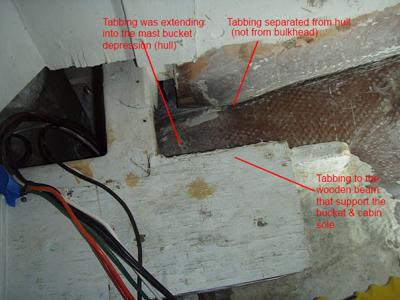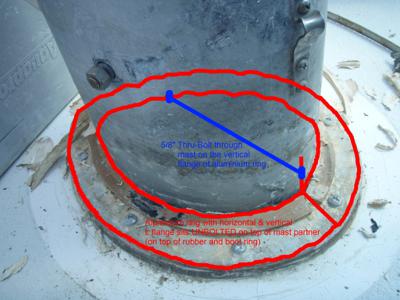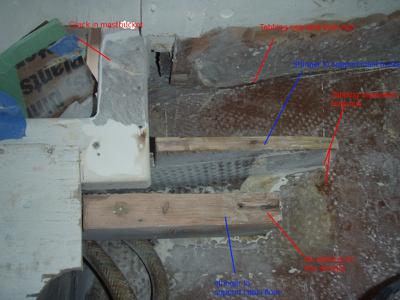<div>Hi All,
I don't particularly like the title of the thread "Fatal Flaw" (no flaw is fatal, a solution is always possible) but since it has been referred as such in the past, in the archives, I'll continue the tradition.
My fiancee and I have been working hard to refit our Morgan 382. We have done lots of work to the anchor well and anchor locker, and will soon be moving to the mast/mast step area.
Our boat (hull #161, 1979) seems to have the documented issue of the sinking IGU, about 1/2" separation between the cabin sole and the head/shower sole. Interestingly, our boat doesn't have any access hatches on either side of the mast bucket, and we wonder whether it was ever recalled and repaired by Morgan.
Additionally, we have noticed distortions in the outside of the hull at the locations where the ends of the short wooden beams supporting the mast bucket meet the hull, as if the ends of the wood beams are being gradually pushed through the hull.
We would therefore like to find out whether the boat was repaired by Morgan, and add reinforcement anyway to slow the sinking of the IGU.
I have read all the archives, and cataloged in the attached document past discussions about the "fatal flaw", but I am still unclear as to what repairs were done by Morgan during the recall? Would anyone be able to explain what the repairs were, and maybe provide pictures of the repairs on their boat?
Then, my understanding is that the sinking of the IGU can be slowed down with various methods that includes tying the mast step to the deck, or the mast to the deck? I would really appreciate if those of you who have created such fittings can describe what was done and/or send pictures, so that I can re-create it myself.
Thanks in advance!
Cheers
Philippe
http://sailing.mcabou.com/
View attachment Fatal_Flaw_of_Morgan_382-17662.unk
Fatal Flaw of Morgan 382.docx
</div>
I don't particularly like the title of the thread "Fatal Flaw" (no flaw is fatal, a solution is always possible) but since it has been referred as such in the past, in the archives, I'll continue the tradition.
My fiancee and I have been working hard to refit our Morgan 382. We have done lots of work to the anchor well and anchor locker, and will soon be moving to the mast/mast step area.
Our boat (hull #161, 1979) seems to have the documented issue of the sinking IGU, about 1/2" separation between the cabin sole and the head/shower sole. Interestingly, our boat doesn't have any access hatches on either side of the mast bucket, and we wonder whether it was ever recalled and repaired by Morgan.
Additionally, we have noticed distortions in the outside of the hull at the locations where the ends of the short wooden beams supporting the mast bucket meet the hull, as if the ends of the wood beams are being gradually pushed through the hull.
We would therefore like to find out whether the boat was repaired by Morgan, and add reinforcement anyway to slow the sinking of the IGU.
I have read all the archives, and cataloged in the attached document past discussions about the "fatal flaw", but I am still unclear as to what repairs were done by Morgan during the recall? Would anyone be able to explain what the repairs were, and maybe provide pictures of the repairs on their boat?
Then, my understanding is that the sinking of the IGU can be slowed down with various methods that includes tying the mast step to the deck, or the mast to the deck? I would really appreciate if those of you who have created such fittings can describe what was done and/or send pictures, so that I can re-create it myself.
Thanks in advance!
Cheers
Philippe
http://sailing.mcabou.com/
View attachment Fatal_Flaw_of_Morgan_382-17662.unk
Fatal Flaw of Morgan 382.docx
</div>




